1993 CHEVROLET S10 fuel cap
[x] Cancel search: fuel capPage 126 of 356
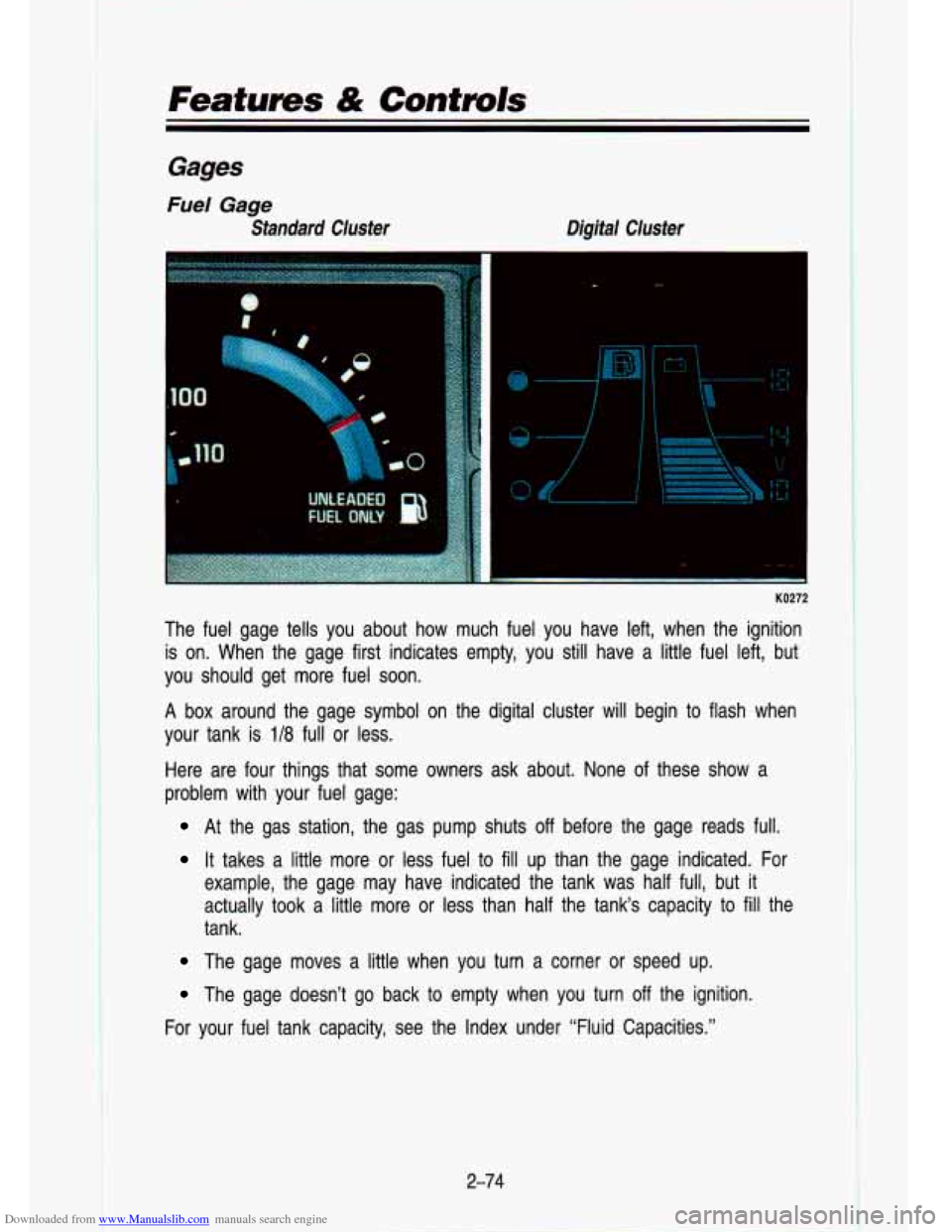
Downloaded from www.Manualslib.com manuals search engine Features & Controls
Gages
Fuel Gage
Standard Cluster Digital Cluster
KO272
The fuel gage tells you about how much fuel you have left, when the ignition
is on. When the gage first indicates empty, you still have a lit\
tle fuel left, but
you should get more fuel soon.
A box around the gage symbol on the digital cluster will begin to flash when
your tank
is 1/8 full or less.
Here are four things that some owners ask about. None of these show a
problem with your fuel gage:
At the gas station, the gas pump shuts off before the gage reads full.
It takes a little more or less fuel to fill up than the gage indicated. For
example, the gage may have indicated the tank was half full, \
but
it
actually took a little more or less than half the tank‘s capacity to fill the
tank.
The gage moves a little when you turn a corner or speed up. \
The gage doesn’t go back to empty when you turn off the ignition.
For your fuel tank capacity, see the Index under “Fluid Cap\
acities.”
2-74
t
Page 255 of 356
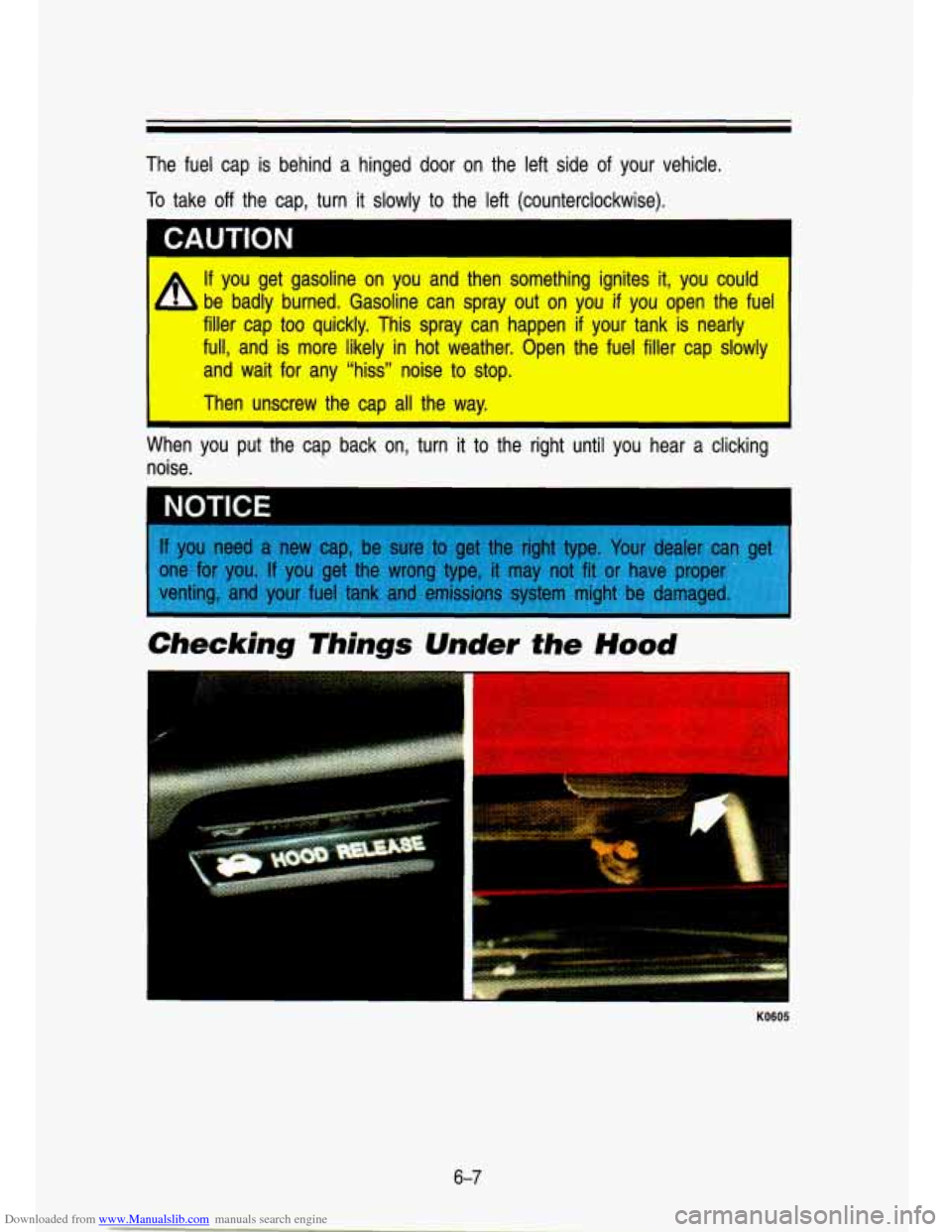
Downloaded from www.Manualslib.com manuals search engine The fuel cap is behind a hinged door on the left side of your vehicle.
To take off the cap, turn it slowly to the left (counterclockwise).
CAUTION
If you get gawline on you and then1 something1 ignites it, you lcould
be badly burned. Easolli’ne can spray out on you if you open the fuel
filler cap too quickly. This spray can happen if your tank is ne,arly
fiulll, and is momre likely in hot weather. Open the fu~el filler cap slbwly
an8d
warit for any “’hiss” mise to stop.
Then unscrew
the cap all the way. I
When you put the cap back on, turn it to the right until you hear a clicking
noise.
NOTICE
Checking nings Under the Hood
KO605
6-7
Page 278 of 356
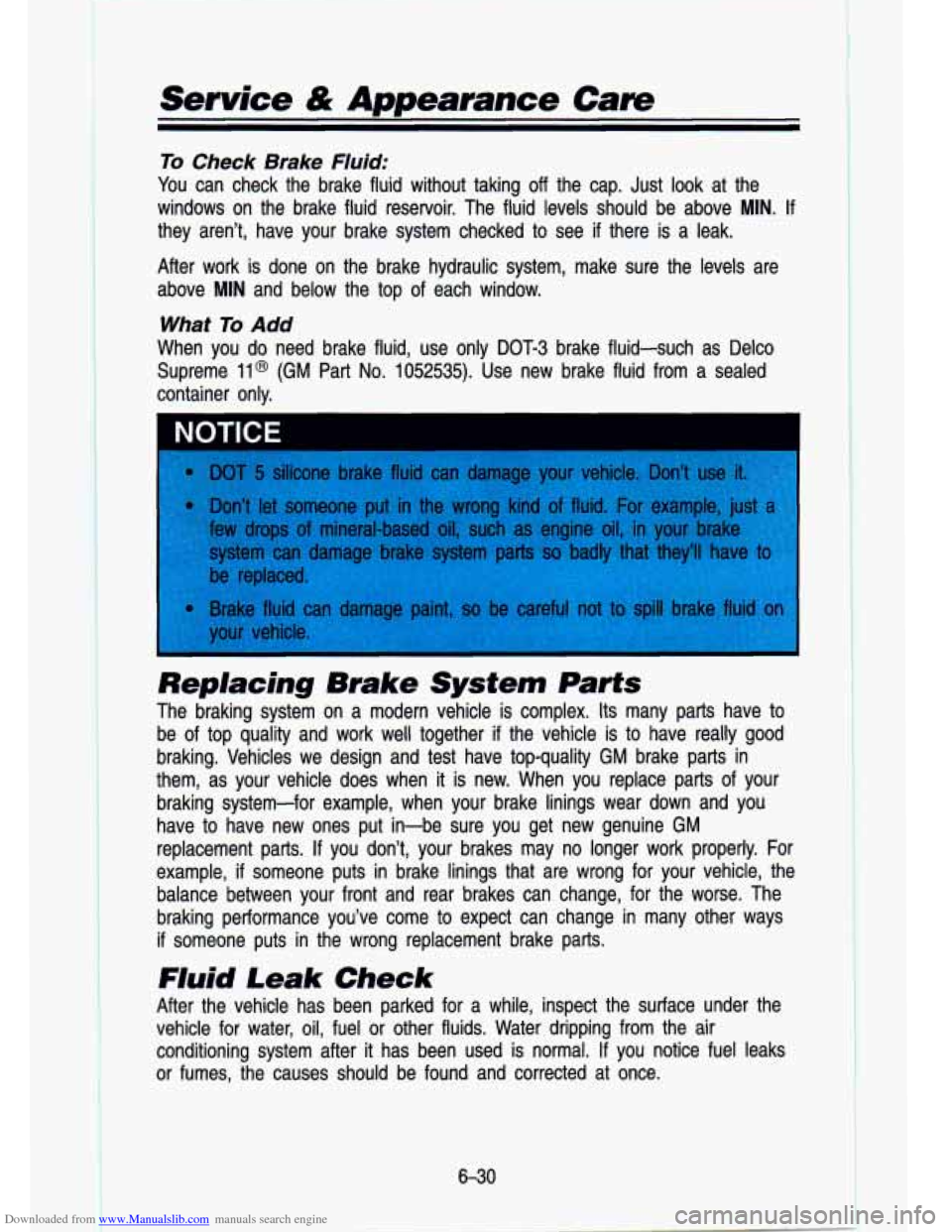
Downloaded from www.Manualslib.com manuals search engine . ..
Service & Appearance Care
To Check Brake Fluid:
You can check the brake fluid without taking off the cap. Just look at the
windows on the brake fluid reservoir. The fluid levels should be above
MIN. If
they aren’t, have your brake system checked to see if there is a leak.
After work is done on the brake hydraulic system, make sure t\
he levels are above
MIN and below the top of each window.
What To Add
When you do need brake fluid, use only DOT-3 brake fluid-such as Delco
Supreme
11 @ (GM Part No. 1052535). Use new brake fluid from a sealed
container only.
Replacing Brake System Parts
The braking system on a modern vehicle is complex. Its many parts have to
be of top quality and work well together if the vehicle is to have really good
braking. Vehicles we design and test have top-quality GM brake parts in
them, as your vehicle does when
it is new. When you replace parts of your
braking system-for example, when your brake linings wear down and you
have to have new ones put in-be sure you get new genuine GM
replacement parts.
If you don’t, your brakes may no longer work properly. For
example,
if someone puts in brake linings that are wrong for your vehicle, the
balance between your front and rear brakes can change, for the\
worse. The braking performance you’ve come
to expect can change in many other ways
if someone puts in the wrong replacement brake parts.
Fluid Leak Check
After the vehicle has been parked for a while, inspect the su\
rface under the
vehicle for water, oil, fuel or other fluids. Water dripping from the air
conditioning system after
it has been used is normal. If you notice fuel leaks
or fumes, the causes should be found and corrected at once.
6-30
Page 286 of 356
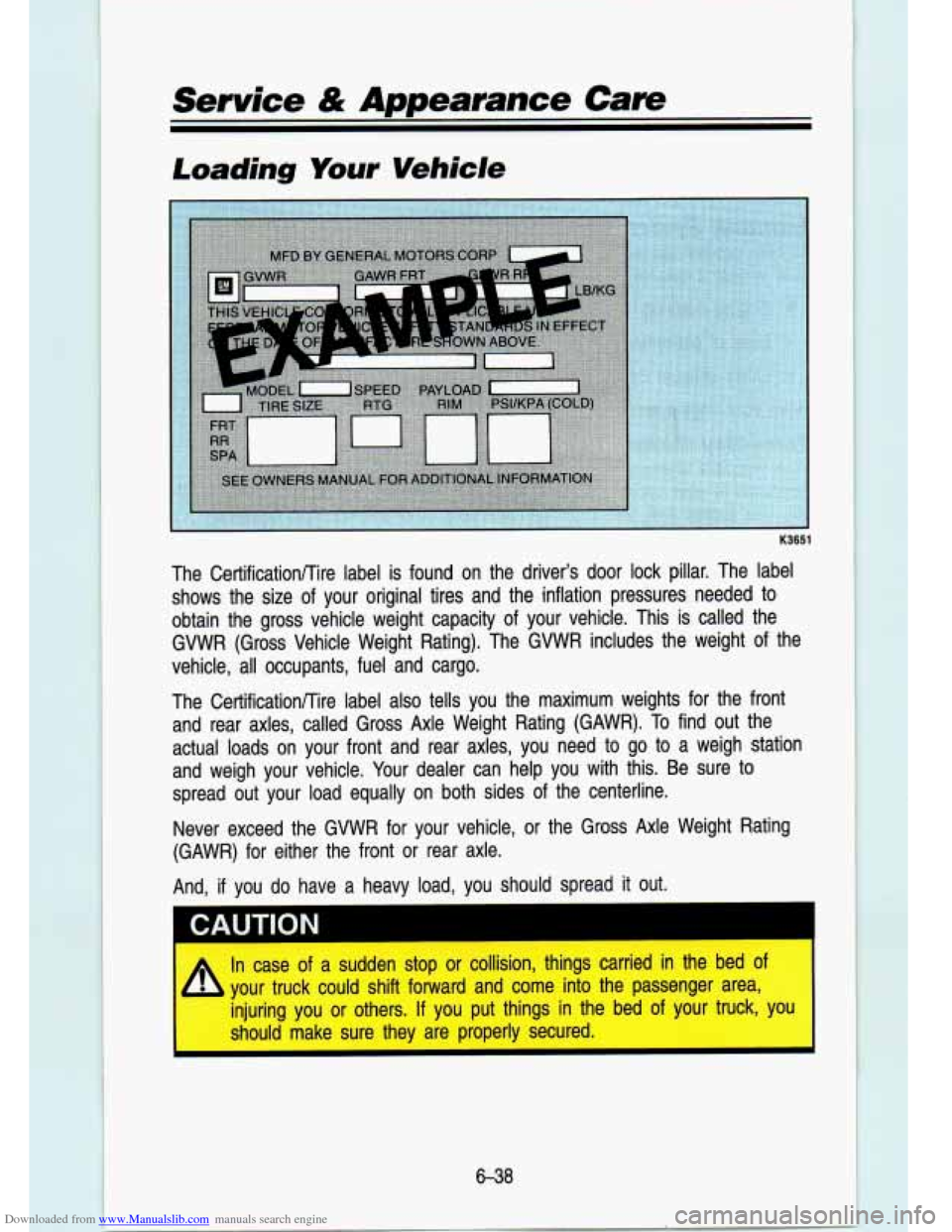
Downloaded from www.Manualslib.com manuals search engine Service & Appearance Care
Loading Your Vehicle
K3651
The CertificationRire label is found on the drive~r's door lock pillar. The label
shows t'he size of your original t'ires and the inflation pressu8res ne-eded to
obtain the gross vehicle weight capac-ity of your vehicle. This
is called the
GVWR (Gross Vehicle Weight Rating). The- GVWR includes the weight of the
vehlicle, all occupants, fuel and cargo.
The Certifi'cationKtre label also tells you the maximum weights for the front
and rear axles, called Gross
Axle Weight Rating (GAWR). To find out the
actual
loads on your front and rear axles, you need to go to a weigh station
and weigh your vehicle. Your dealer can help you with this. Be sure to
spread out your load equally
on both sides of the centerline.
Never exceed the GVWR for your vehicle, or the Gross Axle Wei\
ght Rating
(GAWR) for either the front or rear axle.
And,
if you do have a heavy load, you should spread it out.
I CAUTION
In case of a sudden stop or collision, things carried in the bed\
of
I [I! your truck could shift forward and come into the passenger are\
a
injuring you or others.
If you put things in the bed of your truck,
should make sure they are properly secured.
1
6-38
Page 309 of 356
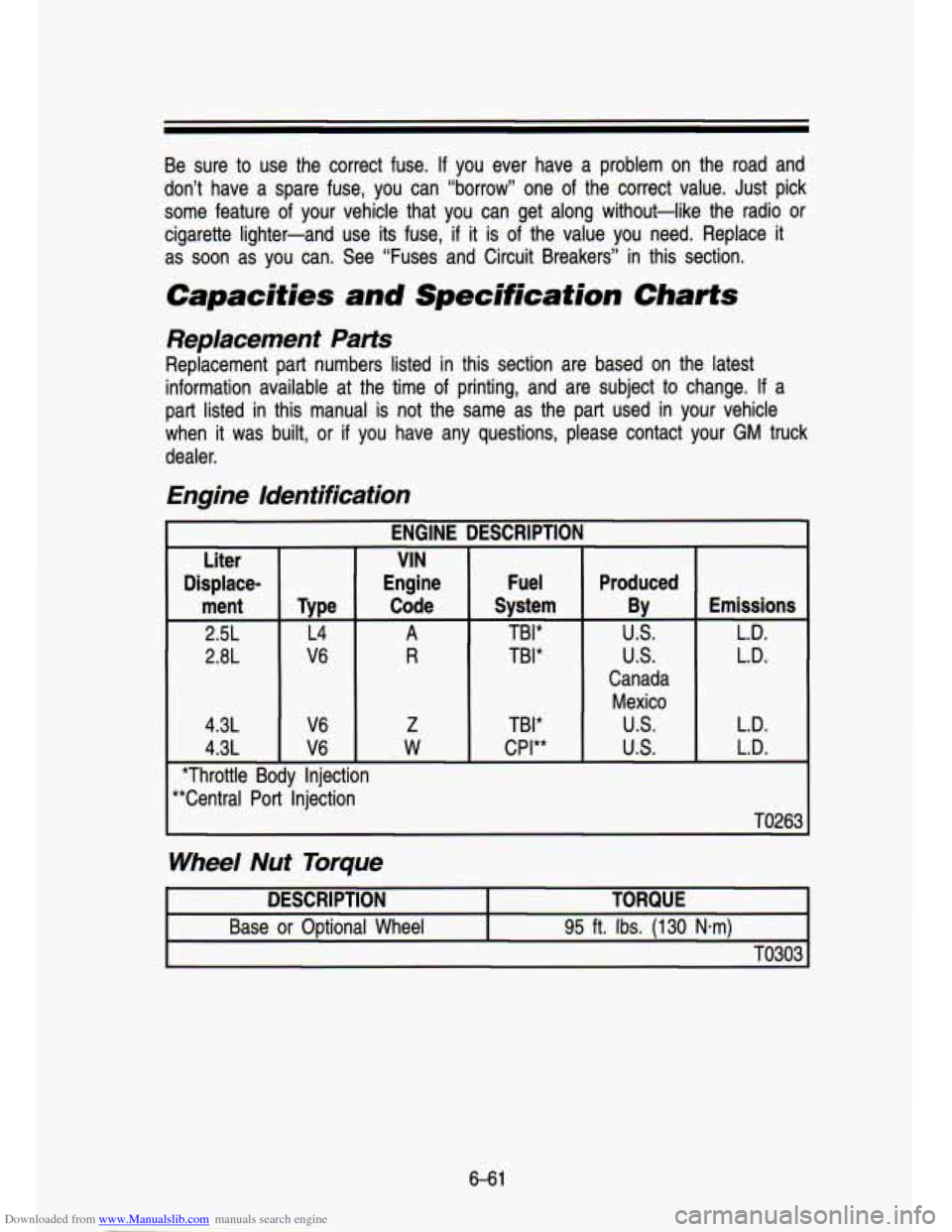
Downloaded from www.Manualslib.com manuals search engine Be sure to use the correct fuse. If you ever have a problem on the road and
don’t have a spare fuse, you can “borrow” one of the correct value. Just pick
some feature of your vehicle that you can get along without-like the radio or
cigarette lighter-and use its fuse,
if it is of the value you need. Replace it
as soon as you can. See “Fuses and Circuit Breakers” in this section.
Cap cities and Specification Charts
Replac -merit Parts
Replacement part numbers listed in this section are based on the latest
information available at the time of printing, and are subject to change.
If a
part listed in this manual is not the same as the part used in your vehicle
when
it was built, or if you have any questions, please contact your GM truck
dealer.
Engine Identification
ENGINE DESCRIPTION I
Liter VJN
Displace- Engine ment Type Cde
2.5L L4
A
2.8L V6 R
4.3L
V6 Z
4.3L V6 W
*Throttle Body Injection
“Central Port Injection Fuel
Svstem
TBI*
TBI*
TBI*
CPI**
Produced
BY
U.S.
us.
Canada Mexico
US.
U.S.
Emissions
L.D.
L.D.
L.D.
L.D.
TO263
Wheel Nut Torque
DESCRIPTION TORQUE
Base or Optional Wheel
95 ft. Ibs. (1 30 Nam)
TO303
6-61
Page 310 of 356
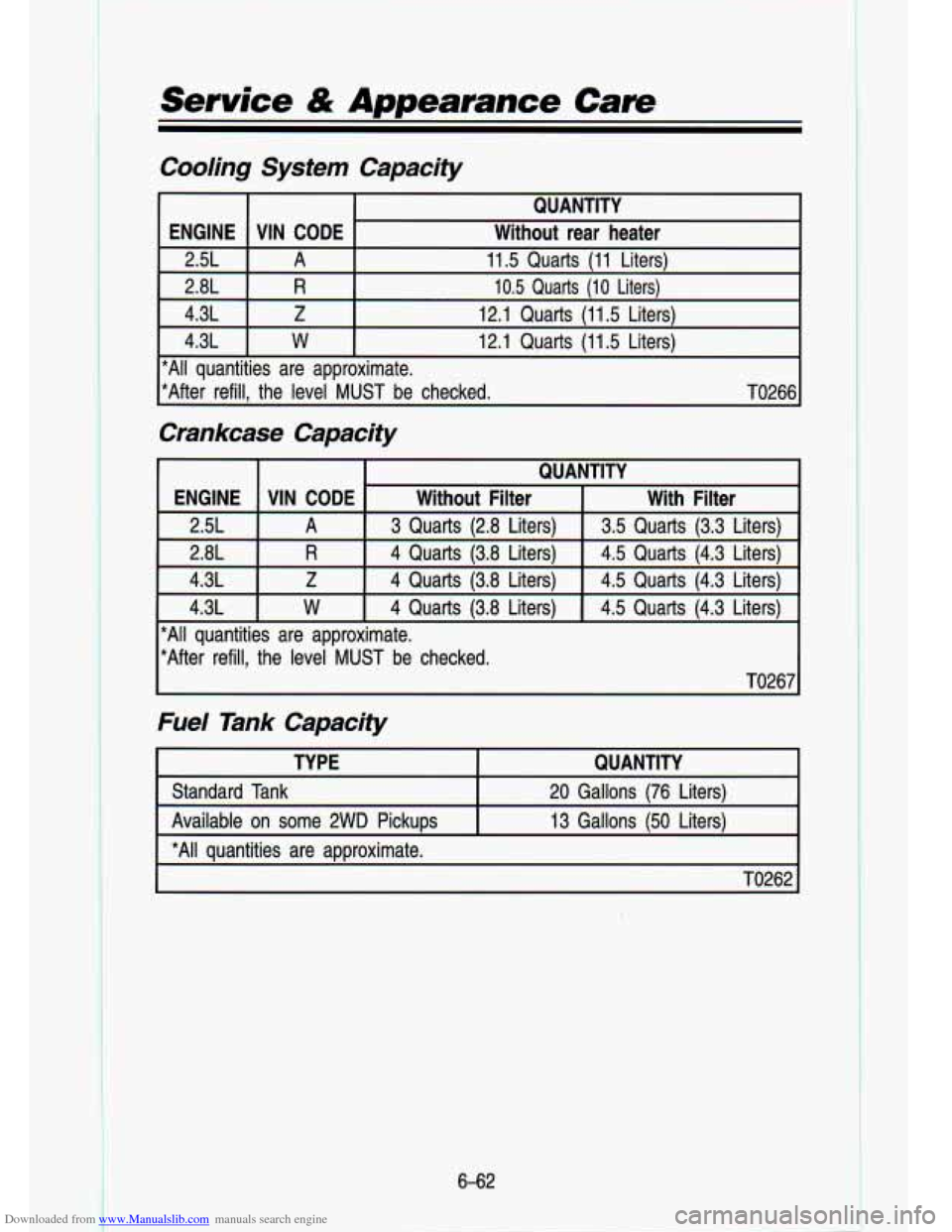
Downloaded from www.Manualslib.com manuals search engine Service & Appearance Care
Cooling Sysfem Capacity
QUANTITY
ENGINE VIN CODE Without rear heater 2.5L
A 11.5 Quarts (11 Liters)
2.8L
R 10.5 Quarts (10 Liters)
4.3L
Z 12.1 Quarts (11.5 Liters)
4.3L W
12.1 Quarts (11.5 Liters)
*All quantities are approximate.
*After refill, the level
MUST be checked. TO266
Crankcase Capacity
ENGINE I VIN CODE I Without Filter I With Filter I
2.5L I A I 3 Quarts (2.8 Liters) I 3.5 Quarts (3.3 Liters) I
2.8L R 4 Quarts (3.8 Liters) 4.5 Quarts (4.3 Liters)
4.3L
Z 4 Quarts (3.8 Liters)
4.5 Quarts (4.3 Liters)
4.3L
I W I 4 Quarts (3.8 Liters) I 4.5 Quarts (4.3 Liters)
*All quantities are approximate.
*After refill, the level
MUST be checked.
TO267
Fuel Tank Capacify
TYPE QUANTITY
Standard Tank 20 Gallons
(76 Liters)
Available
on some 2WD Pickups 13 Gallon- ‘50 Liters)
*All quantities are approximate.
TO262
i
6-62
Page 320 of 356

Downloaded from www.Manualslib.com manuals search engine Scheduled Maintenance Services
SCHEDULED MAINTENANCE SERVICES FOR
I
If your driving conditions meet those specified i
Services” in this Section (or see Index), use
M
Item I I Miles (000) I 3 I 6
No. Service Kilometers (000) 5 10
1 Engine Oil Change*
I -Even/ 3 Months, or
Oil Filter Change*
-Every 3 Months, or
tt
2 Chassis Lubrication-Every 12 Months,
,, Clutch Fork Ball Stud Lubrication (4.3L or J I engines only) I
4 Cooling System Service*-Every 24
1 Months or
5 I Air Cleaner Filter Replacement* I I
6 Front Wheel Bearing Repack (2WD
Only)
7 Transmission Service**
8 Fuel Filter Replacement*
9 Spark Plugs Replacement*
10 Spark Plug Wire Inspection*
11 Engine Timing Check*
12 Fuel Tank, Cap and Lines Inspection*
13 Engine Accessory Drive Belt Inspection*
14 Tire and Wheel Rotation
t
15 Drive Axle Service tt
16 Brake Systems Inspection**
FOOTNOTES:
*An Emission Control Service
**See “Explanation
of Scheduled Maintenapce Services” i n the Index
TO283
7-4
Page 322 of 356

Downloaded from www.Manualslib.com manuals search engine scheduled Maintenance Services
I
SCHEDU--D MAIM 4ANCE SEf -7s FOR
If your driving conditions meet those I
Services” in this Section (or see lnde
Item Miles
(000)
No. Service Kilometers (000)
1 Engine Oil Change*
Oil Filter Change* -Every 12 Months,
or
-Every
12 Months, or
2 Chassis Lubrication-Every 12 Months, or
Clutch Fork Ball Stud Lubrication (4.3L
engines only)
Months or
3
4 Cooling System Service*-Every 24
5 Air Cleaner Filter Replacement*
6 Front Wheel Bearing Repack (2WD
7 Transmission Service**
8 Fuel Filter Replacement*
9 Spark Plugs Replacement*
10 Spark Plug Wire Inspection* 11 Engine Timing Check*
12 Fuel Tank, Cap and Lines Inspection*
13 Engine Accessory Drive Belt Inspection*
14 Tire and Wheel Rotation
15 Drive Axle Service
16 Brake Systems Inspection**
Only)
FOOTNOTES:
*An Emission Control Service
36
5 10
**See “Explanation of Scheduled Maintenance Services” in the Index
TO287
7-6